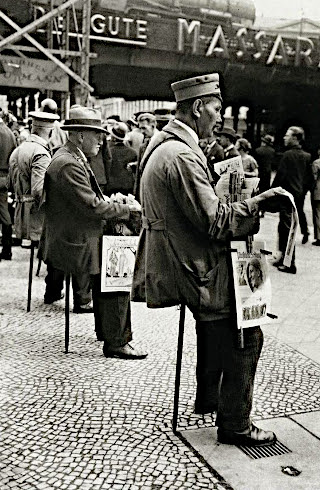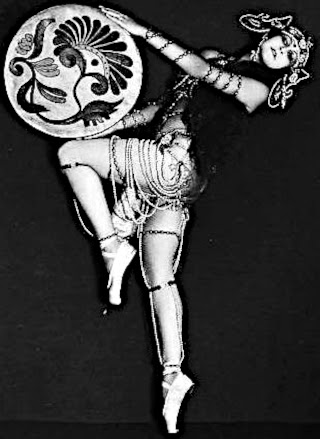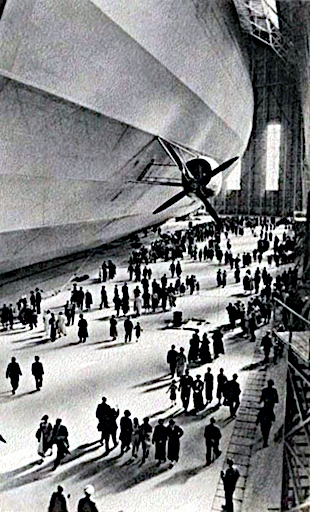Someone asked for a long term chart in gold.
Projecting this leg in the gold bull market has been of keen interest to us on one dimension, since we do have some trading activity in our own account. However, on the long term for our core positions it is of no more interest now than it was when gold was trading at 550, 450, or even 250. Gold is in a bull market, and you never give up your core positions in a bull market. You can trade around them if you are an aggressive trader.
As an aside, to anyone who can read a chart and as you can plainly see for youself, gold is in an obvious bull market. If you are dealing with someone who says it is not then they can only a) be incapable of reading a chart, b) be blinded by a mistaken belief, or c) be talking their or someone else's book. There seem to be a few analysts, never bullish on gold in a spectacular bull market, working for major gold trading houses, that fit into this last category.
So, gold appears to be targeting somewhere just north of 1300 for this leg of its bull market. As it says on the chart, this is a LONG term projection, and it should therefore be expected to play out over the LONG term.
The lower bound on gold on these formations is higher than 925 so we would not expect gold to trade lower than that while these formations are 'working.'
Every bull market has its 'wall of worry.' Gold certainly has its own. Its price increases are being met with fierce opposition by four or five US Wall Street banks who are increasing their paper shorts against it to record numbers.
The game of Wall Street is misdirection and mischief using paper and the control of information. Yesterday's US retail sales data was a nice example of the partnership in deception between Wall Street and Washington to deceive the people for a variety of motives, some well-intentioned and some merely venal.
For this reason the Bankers and the statists hate gold, because it defies their control, and that of the money manipulators, those who would control nations and the many by controlling their money.
16 September 2009
Long Term Gold Chart Targets 1325
US Dollar Long Term Chart and a Scenario for Dollar Devaluation
Here is a long term chart of the US Dollar Index.
The recent rally in the US dollar completed at an almost perfect 38.2% fibonacci retracement from the 70.70 bottom. In part this rally was part of the short squeeze in eurodollars created by the collapse of US dollar financial CDO deposits held by customers at European banks.
The Dollar Rally and the Deflationary Imbalances in the US Dollar Holdings of Overseas Banks
The target for the active H&S top from 121 is still 65. The Key Pivot remains 81, the high end of band which had been the support level held by the dollar for almost 20 years. While the dollar is below 81 the H&S top is active and working.
We have been trying to calculate a new lower bound for the dollar decline from the charts. Reason tells us that at some point the dollar decline and economic imbalances may lead to a devaluation of the dollar.
People have asked, "How can the dollar be devalued? After all, there is no fixed standard."
Well, the dollar can decline considerably in purchasing power of real goods, as it has been doing for many years. However, the dollar can be devalued against its only true measure as a fiat currency: itself.
A formal devaluation of the dollar would be the discontinuance and reissue of the US dollar as a 'new dollar' with some preset exchange rate.
A likely figure would be 100:1, that is, 100 old dollars for 1 new dollar, possibly to be called 'the amero' as some have suggested or simply the 'dollar' as the US dollars currently in use will be withdrawn from circulation. If this does not provide sufficient relief it might have to be repeated.
This is what happened to the Russian rouble on January 1, 1998 after a debt default. Since it is unlikely that the US default will be preceded by a hyperinflation and protracted period of instability, we think the 1000:1 ratio of reissuance used by Russia might be too severe for the dollar, most especially because of its position as the reserve currency.
However, if the new dollar is to be at least partially backed by gold at the insistence of its international trading partners, then 1000:1 seems to 'work' more effectively given the US gold reserves and projected new money supply. This might be accomplished in phases, or with a dual currency regime.
It should also be noted that devaluation alone does not fix economic problems. It is a form of debt default, more severe than mere inflation. After its reissuance in 1998, for example, the new Russian rouble quickly lost approximately 70% of its value against the dollar because the devaluation had not been accompanied by significant economic reform. It has since recovered through painful adjustment.
You should not believe that this scenario is possible for the US dollar, yet. After all, if it was generally accepted and believed that it would happen, a severe value decline would already be underway.
Fiat currencies traffic in confidence. This things tend to play out over months and years, not days, unless there is a precipitating event usually caused by exterior events. Even though there had been a Russian debt default in the 1990's, the rouble had been troubled by serious inflation for many years before that.
But the warning signs are here if you have the eyes to see them, as unlikely as it might seem. It will appear to be a 'no-brainer' to a future generation. "What were they thinking? How could they have been so blind? What made them think that it could go on like that forever?"
However, we are approaching levels of economic imbalance and unserviceable debt levels that should bring at least a bit of a chill in the dollar bulls, as a warning that all things of the earth pass away, as they have done, and will always do. Some things, however, endure longer than others because they are universal, and not particular to a time or place.
In an upcoming blog, we will attempt to explain why the debt destruction in the US, with a moderating of the growth of some of the money supply measures, is not and will not result in a strengthening dollar. We do not expect any one who 'believes' in deflation as espoused by some of the dollar bulls to accept this. After all, they ignore the dollar devaluation that occurred in the depths of the Great Depression, when a devaluation really meant something radical as it was done against a gold standard.
14 September 2009
Robert Reich on Moral Hazard and Obama's Failure
Robert Reich is a top Democrat, former Secretary of Labor under Bill Clinton, and a member of the Obama transition team.
In his recent blog he excoriates the Obama financial team's actions. And in doing so he echoes the things that have been said here, which we will take as some measure of validation from an intelligent public figure and top representative of the party in power.
Surely Obama must see that his Administration is a failure, beginning with his failure to maintain the promise of change, and address the need to reform the financial system.
Do something, Barack. Get a backbone, and do something for the country, and let the special interests, and the cronies of your cronies, be damned.
Start telling it like it is. Make this historic moment memorable, and not a shame.
The Continuing Disaster of Wall Street, One Year Later
Robert Reich
September 13, 2009
As he attempted to do with health care reform last week, the President is trying to breathe new life into financial reform. He's using the anniversary of the death of Lehman Brothers and the near-death experience of the rest of the Street, culminating with a $600 billion taxpayer financed bailout, to summon the political will for change. Yet the prospects seem dubious. As with health care reform, he has stood on the sidelines for months and allowed vested interests to frame the debate. Nor has he come up with a sufficiently bold or coherent set of reforms likely to change the way the Street does business, even if enacted.
Let's be clear: The Street today is up to the same tricks it was playing before its near-death experience. Derivatives, derivatives of derivatives, fancy-dance trading schemes, high-risk bets. “Our model really never changed, we’ve said very consistently that our business model remained the same,” says Goldman Sach's chief financial officer.
The only difference now is that the Street's biggest banks know for sure they'll be bailed out by the federal government if their bets turn sour -- which means even bigger bets and bigger bucks.
Meanwhile, the banks' gigantic pile of non-performing loans is also growing bigger, as more and more jobless Americans can't pay their mortgages, credit card bills, and car loans. So forget any new lending to Main Street. Small businesses still can't get loans. Even credit-worthy borrowers are having a hard time getting new mortgages.
The mega-bailout of Wall Street accomplished little. The only big winners have been top bank executives and traders, whose pay packages are once again in the stratosphere. Banks have been so eager to lure and keep top deal makers and traders they've even revived the practice of offering ironclad, multimillion-dollar payments – guaranteed no matter how the employee performs. Goldman Sachs is on course to hand out bonuses that could rival its record pre-meltdown paydays. In the second quarter this year it posted its fattest quarterly profit in its 140-year history, and earmarked $11.4 billion to compensate its happy campers. Which translates into about $770,000 per Goldman employee on average, just about what they earned at height of boom. Of course, top executives and traders will pocket much more.
Every other big bank feels it has to match Goldman's pay packages if it wants to hold on to its "talent." Citigroup, still on life-support courtesy of $45 billion from American taxpayers, has told the White House it needs to pay its twenty-five top executives an average of $10 million each this year, and award its best trader $100 million.
A few banks like Goldman have officially repaid their TARP money but look more closely and you'll find that every one of them is still on the public dole. Goldman won't repay taxpayers the $13 billion it never would have collected from AIG had we not kept AIG alive. (In one of the most blatant conflicts of interest in all of American history, Goldman CEO Lloyd Blankfein attended the closed-door meeting last fall where then Treasury Secretary Hank Paulson, who was formerly Goldman's CEO, and Tim Geithner, then at the New York Fed, made the decision to bail out AIG.) Meanwhile, Goldman is still depending on $28 billion in outstanding debt issued cheaply with the backing of the Federal Deposit Insurance Corporation. Which means you and I are still indirectly funding Goldman's high-risk operations.
So will the President succeed on financial reform? I wish I could be optimistic. His milktoast list of proposed reforms is inadequate to the task, even if adopted. The Street's behavior since its bailout should be proof enough that halfway measures won't do. The basic function of commercial banking in our economic system -- linking savers to borrowers -- should never have been confused with the casino-like function of investment banking. Securitization, whereby loans are turned into securities traded around the world, has made lenders unaccountable for the risks they take on. The Glass-Steagall Act should be resurrected. Pension and 401 (k) plans, meanwhile, should never have been allowed to subject their beneficiaries to the risks that Wall Street gamblers routinely run. Put simply, the Street has been given too many opportunities to play too many games with other peoples' money.
But, like the health care industry, Wall Street has platoons of lobbyists and an almost unlimited war chest to protect its interests and prevent change. And with the Dow Jones Industrial Average trending upward again -- and the public's and the media's attention focused elsewhere, especially on health care -- it will be difficult to summon the same sense of urgency financial reform commanded six months ago.
Yet without substantial reform, the nation and the world will almost certainly be plunged into the same crisis or worse at some point in the not-too-distant future. Wall Street's major banks are already en route to their old, dangerous ways -- now made more dangerous by their sure knowledge that they are too big to fail.
"It has now become clear that this was no ordinary crash."
Here is an informative piece on the banking crisis in Iceland. The commentary was so well done that we are using it in lieu of our own commentary based on the article in the Daily Telegraph.
What we would like to point out is that in all banking collapses of this sort, fraud and duplicity are always at the heart of it, as larceny is in most great fortunes through history.
The Community Organizer-in-Chief is speaking to New York's Wall Street today, urging them to do the right thing for the country. He still sees himself as precipitating action in others, as a change agent, rather than organizing and leading the action at the forefront. Old habits die hard. He is not an outsider visiting this community. He leads the community. He's the man, now.
Actions speak louder than words. The words are that Wall Street is paying back the taxpayer money with a nice gain. No one seems to be talking about AIG, which is an enormous loss for the taxpayers at the moment well north of 170 billions, and the almost scandalous payments of 100 cents on the dollar that were made on dodgy contracts to the likes of Goldman Sachs that should have been put into default, or at best paid off at pennies on the dollar.
We still hear rumours of ugliness on the 'off balance sheet' portions of some of these big banks, even the ones held up as models of recovery.
So, when Obama chides the Wall Street wiseguys in stern terms to 'do the right thing,' one can forgive us if we hear, in echoes from the back of the room, "do this" and "get bent."
He may as well walk into the aftermath of a vicious bank robbery and say to the perps with cash still in hand, "Now you boys stop doing that this minute. This is the fifth time you have stolen money and endangered the lives of innocent people. You can keep the money, but you had better not do it again.
Sheriff Summers and Deputy Tim, who you know so well from drinking with them after hours at your clubs, will stop you if you do. And remember, Bennie the Bookie has his eye on you. By the way, Rahm says thanks for the gifts and remembrances, as always."
Action, Mr. Obama. Not words. One does not scold even white collar criminals into confessing, much less changing their ways, and warnings do not work when the perps feel that they most surely own you and the advisors around you, given the toothless gestures you are making towards reform.
The Daily Bell
Iceland: what ugly secrets are waiting to be exposed in the meltdown?
September 14, 2009
"Almost a year since the collapse of the Icelandic banks, the rotten nature of these financial corpses is slowly beginning to emerge. Iceland: what ugly secrets are waiting to be exposed in the meltdown? For months rumours of share-ramping, market manipulation, excessive loans to their owners and unusual transfers off-shore have been circling Kaupthing, Glitnir and Landsbanki, whose failure last October left 300,000 British customers unable to access their money. It has now become clear that this was no ordinary crash. Iceland's special investigation into "suspicions of criminal activity" at the three banks is likely to stretch from Reykjavik to London, Luxembourg and the British Virgin Islands. Eva Joly, the French-Norwegian MEP and fraud expert hired by Iceland and now working with the Serious Fraud Office, now believes it will be "the largest investigation in history of an economic and banking bank collapse". - Telegraph
One has to keep in mind that Iceland is a country of about 300,000 people. And yet the "suspicions of criminal activity" stemming from the collapse of one of the world's smallest central banks are likely to spread around the Western world. Here's some more from the article about such "suspicions" ...
When the banks were put into administration last October, experts believed that Iceland's banks had simply fallen prey to the global credit crisis. But Dr. Jon Danielsson, an Icelander who teaches economics at the London School of Economics, believes that while the timing of the crash was dictated by the global banking crisis, the scandal is unique among European financial institutions.
He believes the root of Iceland's problems that have now decimated its economy appear to have started when the government decided to privatize the banks in the early 1990s. "Iceland got its regulations from the EU, which was basically sound," he says. "But the government had no understanding of the dangers of banks or how to supervise them. They got into the hands of people who took risks to the highest possible degree."
Kaupthing fell into the clutches of the Gudmundsson brothers, Ágúst and Lydur, who made their fortunes building up the Bakkavor food manufacturing empire, which supplies hundreds of supermarkets in the UK. Their investment vehicle, Exista, owned 23% of the bank, counting Robert Tchenguiz, the London property entrepreneur as a board member.
Kaupthing's loan book, which was leaked on to the internet last week, shows that around one third, or €6bn (£5.1bn), of its €16bn corporate loan book was going to a small elite group of men connected to the bank's owners and management.
Several investigations into Kaupthing centre on share ramping, where the bank would allegedly give loans with no interest or security in order to buy shares in that same bank - boosting the share price.
Yes, much to be concerned about. But is Danielsson serious about these accusations? He believes that privatization is at the heart of the difficulties? We've heard exactly the opposite of course when it comes to American and British central banks. The Federal Reserve is said to function well (it doesn't) because it is in private hands and immune to political influence (it's not). It's a good sound bite, of course, to say a central bank functions well because it is private, or is well regulated because it is public. But it likely doesn't make any difference.
That's because the institution itself is fatally flawed. If the American or European central bank broke down, and investigations were held into the relationships, all holy hell would likely break loose. How can it be otherwise? These central banks are run by small groups of (mostly) men, who grow up with each other and go to the same clubs and run in the same social circles and have the same interests.
In the case of the Federal Reserve, the best of Goldman Sachs tend to matriculate to government work, and to believe that Goldman Sachs has not benefited from its relationships at the highest levels of Western government is likely naïve in the extreme.
According to Danielsson, the Iceland crisis is "unique among European financial institutions." In fact, we believe it is no such thing. If any one of these other institutions crashed, the "uniqueness" would turn out to be commonplace. The interwoven old boys network does not stop at the doors of central banks. Central banking IS an old boy's network. It is the best and biggest network of all. In this one, you actually get to print money, and if anyone asks you for an accounting, you simply claim that if you release too much information, you will destabilize this or that financial institution.
We think there is a reason that the Federal Reserve, for instance, is resisting the Congressional move for a thorough audit, and it has little to do with a professed concern for the destabilization of banking institutions. We believe, as with Iceland, that central banking is infested with private dealings in millions and even billions of dollars. How could it be otherwise?
Conclusion: Central banking is a franchise of the utmost power and authority, but the men who run it are neither priests nor eunuchs. They are merely human beings, and, after all, while power corrupts, infinite power corrupts infinitely. Only the market itself can guarantee a level playing field. A market-based gold and silver standard would do away with the suspicions that are rife when it comes central banking. The smallest central bank in the world is central to a financial scandal that threatens to engulf much of the West. What secrets must the larger banks hold?






























